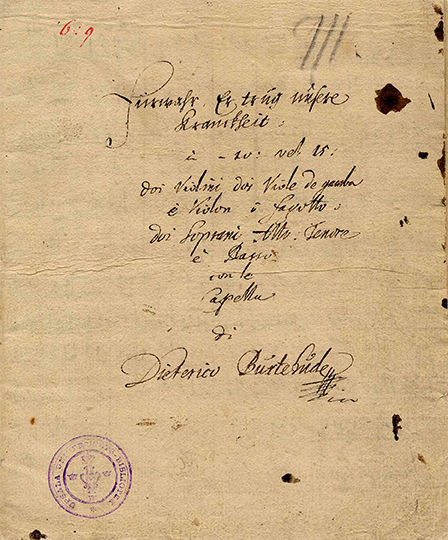Buxtehude in Sweden – The Düben Collection
Dietrich Buxtehude was born in 1637 in what is now Denmark. At the age of 20 he was appointed organist at St. Mary’s Church in Helsingør, where his father had earlier worked and in 1660, he took a position at another St. Mary’s Church, this time in Halsingborg. For the last forty years of his life he worked in Lübeck, where he was organist at yet another St. Mary’s Church and gained renown for is annual series of Abendmusiken. His fame as an organist during his lifetime was considerable and for the first two centuries after his death, knowledge of Buxtehude’s compositions was limited almost entirely the few organ works that had been preserved. His considerable body of vocal and chamber music were assumed to have been lost through fires and the vagaries of time until researchers began to catalog an extraordinary collection of manuscripts in the university library in Uppsala Sweden.
 The remarkable Düben collection, which includes a treasure trove of mostly North German 17th Century music, stems from the efforts of Swedish court organist and Kapellmeister Gustav Düben in gathering music for the royal library during the second half of the 17th Century. Born into a family of organists, Düben studied in Germany in the 1640s before returning to Stockholm to assume his duties under the Swedish king. The centerpiece of Magnificat’s program on the weekend of March 18-20, and Buxtehude’s best known work, Membra Jesu Nostri was in fact dedicated to Gustav Düben, whom the composer referring to him as a “most notable and honored friend” on the title page.
The remarkable Düben collection, which includes a treasure trove of mostly North German 17th Century music, stems from the efforts of Swedish court organist and Kapellmeister Gustav Düben in gathering music for the royal library during the second half of the 17th Century. Born into a family of organists, Düben studied in Germany in the 1640s before returning to Stockholm to assume his duties under the Swedish king. The centerpiece of Magnificat’s program on the weekend of March 18-20, and Buxtehude’s best known work, Membra Jesu Nostri was in fact dedicated to Gustav Düben, whom the composer referring to him as a “most notable and honored friend” on the title page.
Most of the works by Buxtehude in the Düben collection were transmitted in organ tablature, a sort of shorthand notation in common use in Germany since the 15th century. From the tablatures, Düben or copyists employed by the court produced parts for performance. In many cases the tablatures were returned to the composer but in the case of Membra Jesu Nostri, with its dedication to Düben, both the tablature, presumably in Buxtehude’s hand, and Düben’s parts are preserved. There are some interesting variations between the two sources. Düben deletes the ‘coda’ at the end of the first cantata “Ad Pedes”, thus regularizing the symmetrical form with that of the other six cantatas. He also added a third instrumental part in three cantatas.
 The work that opens the program, the cantata Fürwahr er trug unsere Krankheit BuxWV 31, is, like Membra Jesu Nostri, appropriate for Passiontide and sets from Isaiah’s account of the suffering servant. Also preserved in the Düben collection, BuxWV 31 is the only work by Buxtehude that survives in an autograph full score. In commenting on the emotionally intense composition, Kerala Snyder notes “Buxtehude dramatically renders the response of the community to the suffering servant in ever-increasing intensity, from duet, to trio, to the entire ensemble, the latter in close imitative counterpoint.” Snyder suggest that in this work “we may catch a glimpse of the dramatic power of the Abendmusiken.”
The work that opens the program, the cantata Fürwahr er trug unsere Krankheit BuxWV 31, is, like Membra Jesu Nostri, appropriate for Passiontide and sets from Isaiah’s account of the suffering servant. Also preserved in the Düben collection, BuxWV 31 is the only work by Buxtehude that survives in an autograph full score. In commenting on the emotionally intense composition, Kerala Snyder notes “Buxtehude dramatically renders the response of the community to the suffering servant in ever-increasing intensity, from duet, to trio, to the entire ensemble, the latter in close imitative counterpoint.” Snyder suggest that in this work “we may catch a glimpse of the dramatic power of the Abendmusiken.”
The entire Düben Collection has been digitized, thereby making this marvellous body of works available for study and performance. Even before this program, Magnificat has used this remarkable source. For our 2011 reconstruction of a Dresden Christmas Vespers, Magnificat’s artistic director Warren Stewart transcribed Court Kappelmeister Vincenzo Albrici’s setting of the psalm Lætatus sum, a unique copy of which is preserved in the Düben Collection. The Collection is also the only source for the vocal and obligato parts for Schütz’s Weihnachtshistorie, also featured on that program. In all the collection contains vocal and instrumental works by more than 300 composers from Germany, Italy, France, Poland, England, the Baltic countries and Sweden, besides a large number of anonymous works. You can explore the collection at the Uppsala University website.